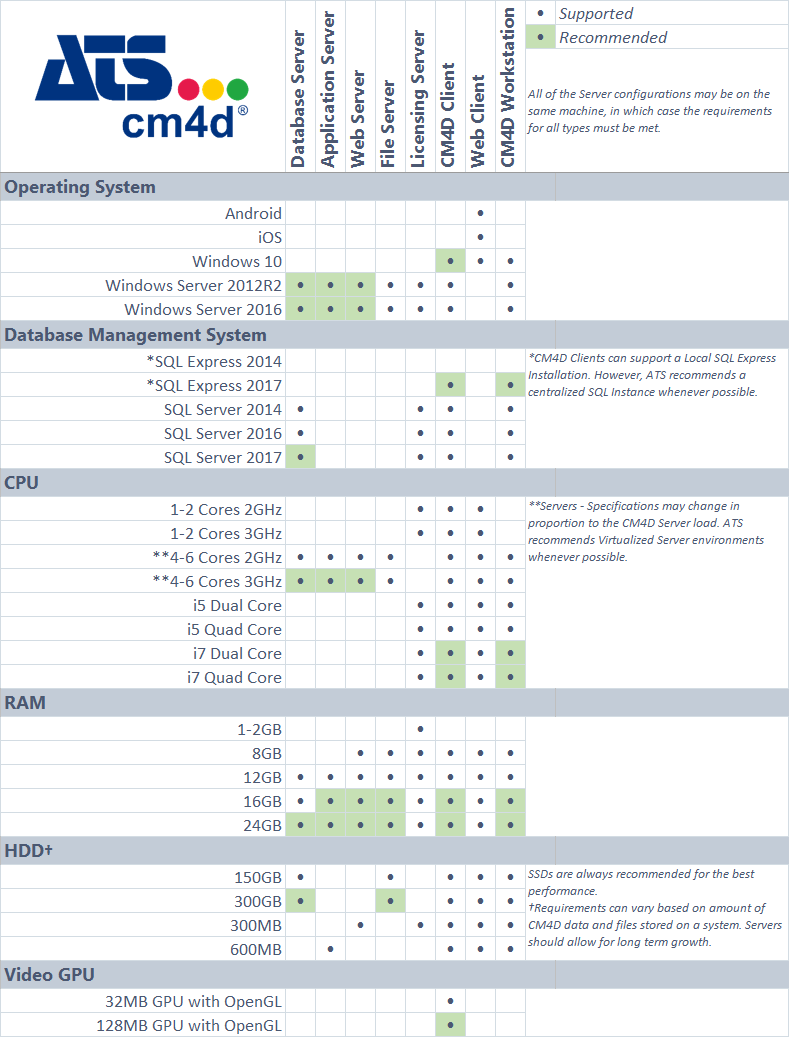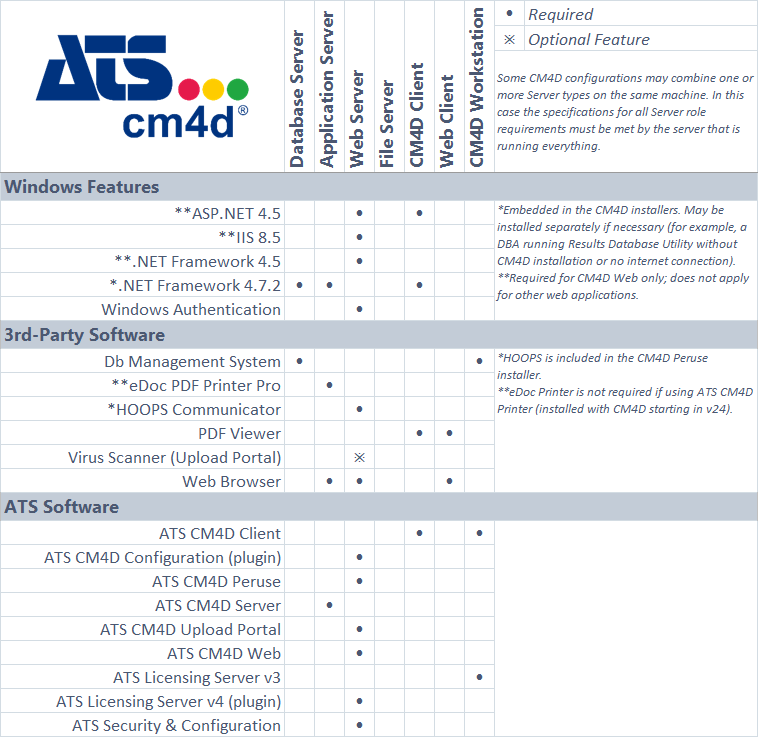Disclaimer: ATS will stop providing support to a customer for a Windows Operating System when Microsoft stops supporting the version.
This document lists the hardware and software requirements and recommendations for the basic configurations of CM4D v25 or higher. These specifications outlined here are intended to be a generic guide to use as a starting point in the planning of your ATS CM4D implementation.
Windows System Updates should be kept up to date to ensure the computer has any critical Root Certificate updates that might be required by digitally signed software.
Notes on Server Memory
The CM4D Automation Server package arrives pre-configured with a single DataSmith Batch process and two CM4D worker processes for CM4D Scheduler. In addition, the CM4D Web application requires its own dedicated CM4D worker processes. The number of CM4D Web worker processes should be based on the number of users who are simultaneously generating reports on demand.
Utilizing current Virtualization technology, you could monitor peak memory demand over time to better tune available memory to prevent page swapping. Most Virtualization technology also makes used of shared or balloon memory, which allows the host to dynamically adjust available memory based on load demand.
For information from Microsoft on Memory Limits for Windows Releases, visit: http://msdn.microsoft.com/en-us/library/windows/desktop/aa366778(v=vs.85).aspx
CM4D Servers
The following software and hardware requirements must be met for the Server that will be running a CM4D Server installation. Server types required to run CM4D include:
- CM4D Database Server - see here
- CM4D Application Server - see here
- Hoops Communicator Server - see here
- CM4D Web Server - see here
- ATS License Server - see here
- CM4D File Server - see here
Some CM4D configurations may combine one or more Server types on the same machine. In this case the specifications for all Server role requirements must be met by the server that is running everything.
Typical use: Large networks with one or more servers hosting centralized databases and running the Site Automation services for multiple CM4D Clients.
CM4D Database Server
The Database Server hosts the Database Management System (i.e., SQL Server) for the CM4D databases. The DBMS can be local to the CM4D installation or on a centralized server within the network.
All installations of ATS CM4D rely on an external database to store the quality data.
Operating System
- Windows Server 2012R2
- Windows Server 2016
- Windows Server 2019
- Windows Server 2022
CPU
Specifications may change in proportion to the CM4D Server load. ATS recommends Virtualized Server environments whenever possible.
- 4-6 Cores 2GHz
- 4-6 Cores 3GHz
RAM
- 12GB-16GB or higher (at least 24GB is recommended)
HDD
Disk sizing requirements can vary based on amount of CM4D data and files stored on a system. Servers should allow for long term growth. Your actual sizing will be based on the volume of measurement data you plan to store and analyze with CM4D.
- 150GB or more
SSDs are always recommended for the best performance.
Database Management System
- SQL Server 2016 or higher
- SQL Server Instance Feature (required for the Results Database):
- Full-Text and Semantic Extractions for Search (see here for instructions)
Firewall Settings
- TCP 1433-1434 – SQL Server Databases
CM4D Application Server
The Application Server typically includes the CM4D Server desktop applications and automation services.
Operating System
- Windows Server 2012R2
- Windows Server 2016
- Windows Server 2019
- Windows Server 2022
CPU
Specifications may change in proportion to the CM4D Server load. ATS recommends Virtualized Server environments whenever possible.
- 4-6 Cores 2GHz
- 4-6 Cores 3GHz
The number of threads should correlate to the number of worker processes you intend to have running on a single machine. A large number of processes without sufficient threads can bottleneck your entire system.
RAM
- 12GB-16GB or higher (at least 16GB is recommended)
HDD
- 600MB (software installation footprint)
Network
- 1GB Network speed
Firewall Settings
- TCP 36057 - CM4D Scheduler
Third Party Software
- eDocPrinter PDF Pro 6.98.6405
 (alternate option – CM4D Printer from ATS)
(alternate option – CM4D Printer from ATS) - Web Browser (Chrome, Edge, Firefox)
Prerequisites
Downloading and installing these prerequisites is only required if you plan to run the installer on a machine that does not have an internet connection. With an internet connection, any prerequisites not present or require updates are downloaded automatically when needed during installation.
- .NET Framework 4.7.2 or higher
- Visual C++ Redistributable for Visual Studio 2012 Update 4 x64 - 11.0.61030
- Microsoft Visual C++ 2015-2019 Redistributable (x64) - 14.25.28508 or higher
- SQL Server OLE DB Driver 18 x64 - 18.2.2.0 or higher
Web Server
The Web Server hosts the following web applications: CM4D Peruse, CM4D Upload Portal or CM4D Web. It may also host the administrative tool, ATS Security and Configuration Manager and its supporting plugins (such as ATS Licensing Server and CM4D Configuration).
Operating System
- Windows Server 2012R2
- Windows Server 2016
CPU
CPU specifications may change in proportion to the CM4D Server load. ATS recommends Virtualized Server environments whenever possible.
- 4-6 Cores 2GHz
- 4-6 Cores 3GHz
RAM
- 8GB or higher (at least 16GB is recommended)
HDD
- 200MB (software installation footprint)
Network
- 1GB Network speed
Windows Features
CM4D Web only:
- Internet Information Services (IIS) 8.5 or higher
- ASP.NET 4.5
- Windows Authentication
Firewall Settings
- CM4D Peruse: TCP 4000, 2000
- CM4D Upload Portal: TCP 4600, 4500, 3200
- CM4D Web: TCP 80
ATS License Server
ATS CM4D v25 and higher requires ATS Licensing Server 4.0. or higher. This is a plugin application that must be installed on the same machine as ATS Security and Configuration Manager.
Operating System
- Windows Server 2012R2
- Windows Server 2016
CPU
- 1-2 Cores 2GHz
- 1-2 Cores 3GHz
RAM
- 2GB or higher
HDD
- 300MB (software installation footprint)
Database Management System
An external DBMS is only required if you are not using the built-in Firebird database for license storage.
- SQL Server 2016 or higher
Default Port(s)
- TCP 8001 - ATS Licensing (see here for more details)
CM4D File Server
The ATS CM4D applications require a shared location to store and access related files such as:
- CM4D Report Templates - *.4dc
- DataSmith translators - *.4DataSmith
- Model Images (2D/3D) - *.wrl, *.jpg, etc.
- RAW Incoming Data Inboxes
- Rendered Reports - *.PDF
These files are used or produced by CM4D Server, CM4DWeb, and any CM4D Clients. For example, if an End User running a CM4D Client does not have access to the file share storing the *.4DC files, they will not be able to view or edit the report templates.
If that CM4D report template includes any part models, the user will also need to have at least read access to the folder where the image file is stored.
Since CM4D is Windows based, this location is represented as a normal Microsoft Windows SMB File Share. For most CM4D Customers, the SMB share used for CM4D files usually resides directly on the CM4D Automation server or on another preexisting SMB file server (such as existing file shares used by used by Quality Department).
Operating System
- Windows Server 2012R2
- Windows Server 2016
- Windows Server 2019
- Windows Server 2022
CPU
Specifications may change in proportion to the CM4D Server load. ATS recommends Virtualized Server environments whenever possible.
- 2-4 Cores 2GHz
- 2-4 Cores 3GHz
RAM
- 8GB or higher (at least 16GB is recommended)
HDD
Disk sizing requirements can vary based on amount of CM4D data and files stored on a system. Your actual sizing will be based on the volume of measurement data you plan to store and analyze with CM4D.
- 150GB or more
SSDs are always recommended for the best performance.
Network
- 1GB Network speed
Firewall Settings
- TCP 445 (Netbios 137-139) – Windows File Share for CM4D document and translators (see here for more details)
CM4D Clients
The following software and hardware requirements must be met for the machine that will be running a CM4D Client installation. There are two primary ways the Client version of CM4D might be implemented:
CM4D Client - Installed on a machine that connects to a centralized database and utilizes components from an Application Server or other shared network resources used by CM4D.
CM4D Workstation - This is a standalone instance of CM4D
CM4D Workstation
This section includes the requirements for CM4D Clients that will have the CM4D installation, ATS Licensing, and database on the same machine.
Typical use: This configuration is usually the Node-locked CM4D Classic Developer and DataSmith licenses and is used by report template developers and DataSmith translator developers.
Other use: CM4D Interactive or CM4D Workcell systems.
Hardware
Operating System
- Windows 10
CPU
- i5 Dual or Quad Core
- i7 Dual or Quad Core
RAM
- 8GB or higher (at least 16GB is recommended)
HDD
Disk sizing requirements can vary based on amount of CM4D data and files stored on a system. Your actual sizing will be based on the volume of measurement data you plan to store and analyze with CM4D.
- 400MB (software installation footprint)
- 150GB or more if storing the database, data files, documents, and licensing
SSDs are always recommended for the best performance.
Video GPU
A discrete GPU is preferred.
- 32MB GPU with OpenGL
- 128MB GPU with OpenGL
CM4D and DataSmith dialogs require a minimum screen resolution of 1280x1024. For wide screens, a minimum resolution of 1920x1080 is recommended.
Database Management System
CM4D Clients can support a local SQL installation. However, ATS recommends a centralized SQL Instance whenever possible. See here for Database Server requirements.
- SQL Server 2016 or higher
- SQL Server Instance Feature (required for the Results Database):
- Full-Text and Semantic Extractions for Search (see here for instructions)
Licensing
- ATS Licensing 4.0. or higher
Prerequisites
- .NET Framework 4.7.2 or higher (included with the CM4D installer, but can be installed manually if needed)
Web Client
A Web Client refers to a user connecting remotely (via web browser or mobile device) to CM4D Peruse, CM4D Upload Portal or CM4D Web applications hosted on a Web Server. This configuration does not require any installed ATS software products.
Typical use: Multiple users throughout the network, those with limited knowledge of CM4D, but need on-demand access to reports.
Hardware
Operating System
- Windows
- iOS
- Mobile Devices with a compatible web browser and PDF viewer
Software
Third Part Software
- PDF Viewer - Chrome and Edge have built-in pdf viewers
- Web Browser - all major browsers are compatible with CM4D Web (Chrome, Firefox, Internet Explorer, Microsoft Edge, Opera and Safari)
Firewall Port Reference
Hardware Reference

Software Reference
